NATURE OF CONSUMER BEHAVIOR
MEANING OF CONSUMER BEHAVIOR
Consumer Behaviour involves the thoughts and feelings people experience and the actions they perform in consumption processes. Consumer Behaviour is dynamic, involves interactions, and involves exchanges.
ACCORDING TO PROF. C G WALTER
Consumer behaviour refers to the action and decision processes of people who purchase goods and services for personnel consumption.” James. F. Engel “Consumer behaviour is the process whereby individual decides, when, what, where, how and from where to purchase goods and services.”
ACCORDING TO PROF. GW PAUL
“Consumer behaviour is all the psychological social and physical behaviour of potential. Customers as they become aware to evaluate, purchase, consume and tell others about the products and services.”
ACCORDING TO LEON G. SCHIFFMAN
“Consumer behaviour is the behaviour that consume displays in searching for purchasing, using, evaluating and disposing of the products and services that they expect will satisfy their needs.”
ACCORDING TO BEARDEN
“Consumer behaviour refers to the mental and emotional processes and they physical activities of people who purchase and use goods and services to satisfy particular needs.”
ACCORDING TO AMERICAN MARKETING ASSOCIATION
“The dynamic interaction of affect and cognition, Behaviour, and the environmental events by which human beings conduct the exchange aspects of their lives”
ACCORDING TO C L NARAYANA AND R L MARKIN
“Consumer Behaviour is the study of how, why and what people do when they buy products and avail of some services. It attempts to understand the buyer decision making process, both individually and in groups.”
NATURE OF CONSUMER BEHAVIOR
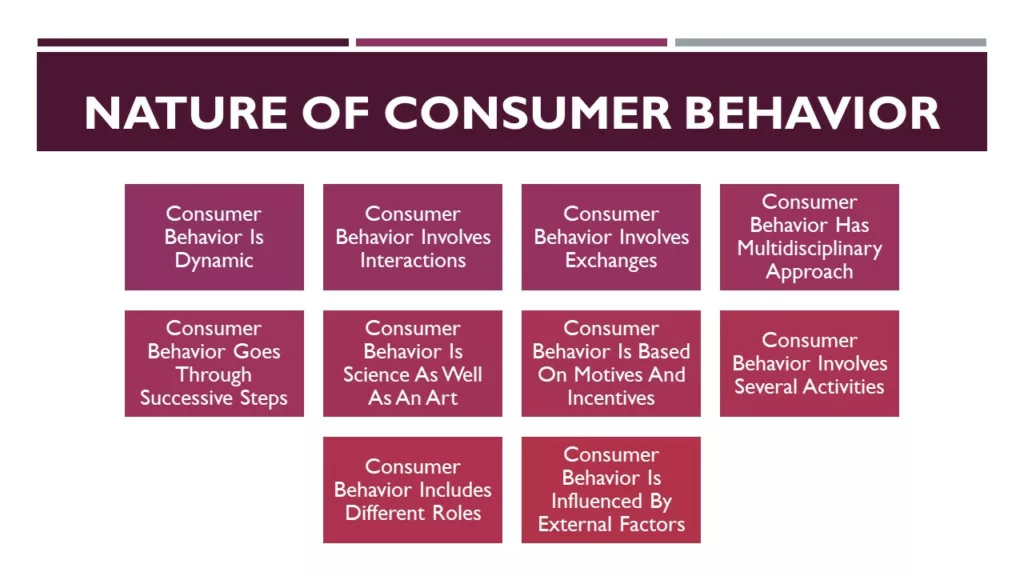
CONSUMER BEHAVIOR IS DYNAMIC
Consumer behavior is dynamic, constantly changing and evolving over time. It is influenced by a multitude of factors, both internal and external. Consumers’ needs, desires, and preferences are not fixed but can shift due to personal circumstances, societal trends, and new experiences. External influences, such as advertising, social media, and cultural norms, play a significant role in shaping consumer behavior.
Market dynamics, including economic conditions and industry trends, also impact consumer choices. Technological advancements further contribute to the dynamism of consumer behavior, as they redefine how consumers interact with brands and make purchasing decisions. Additionally, individual differences and life stage transitions affect consumer behavior as individuals grow and develop. Recognizing the dynamic nature of consumer behavior is essential for businesses to stay competitive, adapt their strategies, and deliver relevant products and experiences that meet the evolving needs and desires of consumers.
CONSUMER BEHAVIOR INVOLVES INTERACTIONS
Consumer behavior involves interactions, highlighting the social and relational aspects of how consumers make decisions. Consumers do not exist in isolation but are influenced by and engage with others in their decision-making processes. Interactions can take various forms, such as seeking opinions and recommendations from friends, family, and online communities, participating in word-of-mouth discussions, and relying on reviews and testimonials.
- Reference groups play a significant role, as consumers compare their choices and behaviors with those of others who share similar characteristics or values.
- Companies also foster interactions by involving consumers in co-creating products and services, seeking their input and feedback.
- Interactions with customer service representatives and sales personnel shape consumer experiences and perceptions.
Recognizing the importance of interactions in consumer behavior enables businesses to understand and leverage the power of social influence, word-of-mouth marketing, customer engagement, and collaboration to effectively reach and satisfy their target audience.
CONSUMER BEHAVIOR INVOLVES EXCHANGES
Consumer behavior involving exchanges refers to the transactional nature of consumer interactions with businesses. It highlights the process of consumers exchanging money, time, or other resources in return for goods, services, or experiences.
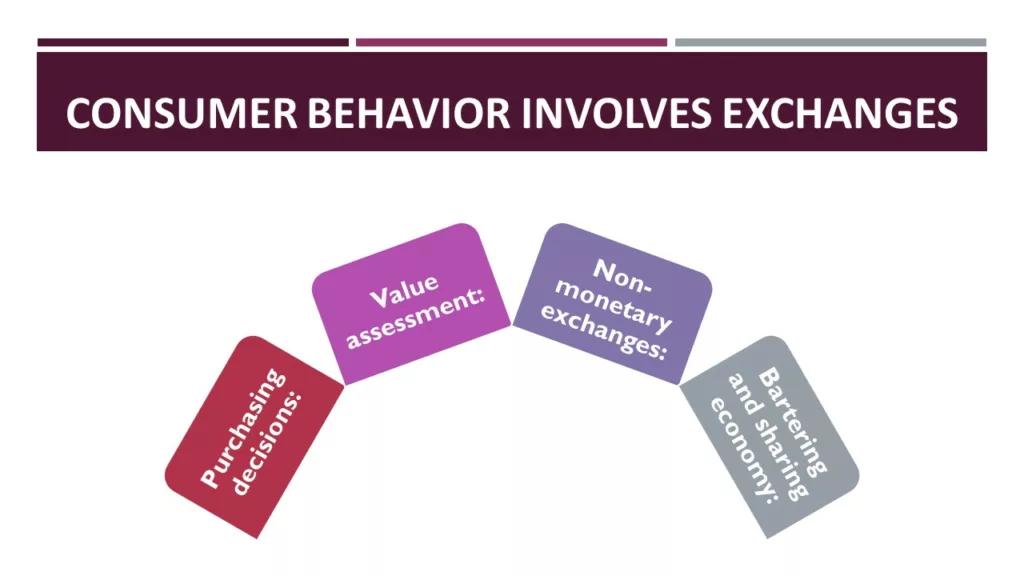
- Purchasing decisions: Consumers engage in the exchange of money for products or services they deem valuable. They evaluate options, compare prices, and make choices based on their perceived benefits and costs. The exchange occurs when consumers complete a purchase transaction.
- Value assessment: Consumers assess the value they expect to receive from an exchange. They consider factors such as product quality, functionality, brand reputation, and price to determine if the exchange is worth it. The perceived value influences their willingness to engage in the exchange and affects their overall satisfaction.
- Non-monetary exchanges: While monetary exchanges are prevalent, consumer behavior also encompasses non-monetary exchanges. Consumers invest time, effort, and personal information in various activities such as research, participating in loyalty programs, providing feedback, or engaging with brand content on social media. These exchanges contribute to building relationships, accessing personalized experiences, and receiving rewards or benefits.
- Bartering and sharing economy: Consumer behavior extends beyond traditional monetary exchanges. Bartering, where consumers exchange goods or services directly without the involvement of money, is an example. Additionally, the sharing economy, enabled by platforms like Airbnb or Uber, involves consumers exchanging access to assets or services rather than owning them outright.
CONSUMER BEHAVIOR HAS MULTIDISCIPLINARY APPROACH
Consumer behavior having a multidisciplinary approach means that it draws insights and theories from various disciplines to understand and explain consumer actions and decisions. It recognizes that consumer behavior is influenced by a wide range of factors that extend beyond a single discipline’s perspective. Several disciplines contribute to the understanding of consumer behavior, including psychology, sociology, anthropology, economics, marketing, and neuroscience.

- Psychology: Psychology provides insights into individual consumer behavior by studying cognitive processes, motivations, perceptions, and attitudes. It helps understand how consumers process information, make decisions, and respond to marketing stimuli.
- Sociology: Sociology explores how social factors, such as social norms, culture, social class, and reference groups, shape consumer behavior. It examines how individuals are influenced by their social environment, social interactions, and the broader society.
- Anthropology: Anthropology examines the cultural and societal influences on consumer behavior. It investigates how cultural values, rituals, symbols, and traditions impact consumer choices and preferences across different societies and cultures.
- Economics: Economics analyzes consumer behavior from a rational decision-making perspective. It focuses on concepts such as utility, demand, price sensitivity, and economic factors that influence consumer choices, including income, price, and market conditions.
- Marketing: Marketing plays a central role in understanding consumer behavior. It combines insights from various disciplines to develop strategies that effectively target, attract, and engage consumers. It incorporates elements of psychology, sociology, economics, and communication to create value, segment markets, and influence consumer decision-making.
- Neuroscience: Neuroscience investigates the neural processes and brain mechanisms underlying consumer behavior. It helps uncover the subconscious influences, emotions, and neural responses that affect consumer preferences, brand perception, and decision-making.
By taking a multidisciplinary approach, researchers and marketers gain a holistic understanding of consumer behavior. It allows for a comprehensive exploration of the complex interplay between psychological, social, cultural, economic, and biological factors. This interdisciplinary perspective helps identify patterns, trends, and insights that inform the development of effective marketing strategies, consumer segmentation, and product innovation.
CONSUMER BEHAVIOR GOES THROUGH SUCCESSIVE STEPS
Consumer behavior going through successive steps refers to the process that consumers typically go through when making purchasing decisions. These steps are commonly referred to as the consumer decision-making process or the buyer’s journey. While the exact number and terminology of the steps may vary, they generally include the following stages:

- Need recognition: The consumer recognizes a need or a problem to be solved. This can be triggered by internal stimuli (e.g., hunger, desire for a new product) or external stimuli (e.g., advertising, recommendations).
- Information search: The consumer seeks information to gather options and evaluate potential solutions. This can involve internal searches (drawing from personal knowledge and experience) or external searches (researching online, seeking recommendations, consulting reviews).
- Evaluation of alternatives: The consumer compares and evaluates different alternatives based on various criteria, such as price, quality, features, brand reputation, and personal preferences. This step aims to assess which option best satisfies their needs and preferences.
- Purchase decision: The consumer makes a decision and selects a specific product or service to purchase. This decision can be influenced by factors like price, availability, brand loyalty, and the overall perceived value.
- Post-purchase evaluation: After the purchase, the consumer evaluates their satisfaction with the chosen product or service. This assessment includes comparing the actual experience with their expectations. Positive experiences can lead to repeat purchases and brand loyalty, while negative experiences can result in dissatisfaction and negative word-of-mouth.
- Post-purchase behavior: Depending on their satisfaction or dissatisfaction, consumers may engage in post-purchase behavior, which can include repurchasing, seeking support or assistance, providing feedback, or sharing their experience with others.
These successive steps provide a framework for understanding how consumers progress through a decision-making process. However, it is important to note that consumer behavior is not always linear or strictly sequential. Consumers may engage in different decision-making patterns depending on the complexity of the purchase, their level of involvement, and the situational factors at play.
CONSUMER BEHAVIOR IS SCIENCE AS WELL AS AN ART
Consumer behavior is considered both a science and an art, reflecting its multidimensional nature and the diverse approaches used to study and understand it.
Science: Consumer behavior as a science emphasizes the systematic and empirical study of consumer actions and decisions. It relies on rigorous research methods, data analysis, and theoretical frameworks to uncover patterns, trends, and generalizable insights. Researchers employ quantitative and qualitative methodologies to examine consumer behavior, conduct experiments, and collect data for analysis. Scientific approaches provide a foundation for understanding consumer behavior through the application of psychological, sociological, economic, and other scientific principles. This scientific approach helps identify causal relationships, develop predictive models, and generate evidence-based strategies for businesses.
Art: Consumer behavior as an art recognizes the subjective and creative elements involved in understanding and influencing consumer actions. It involves the application of intuition, creativity, and strategic thinking to interpret consumer insights and develop effective marketing strategies. Marketers and practitioners often rely on their experience, understanding of consumer motivations, and ability to connect emotionally with consumers to design compelling campaigns, innovative products, and engaging customer experiences. The art of consumer behavior involves storytelling, branding, design, and the ability to appeal to consumers’ emotions, desires, and aspirations.
The science and art of consumer behavior are intertwined, and both are essential for a comprehensive understanding and effective application in marketing and business strategies. While the scientific approach provides a structured and systematic framework for studying consumer behavior, the art aspect brings in the human element and creativity required to connect with consumers on a deeper level. The integration of scientific insights with artistic approaches enables businesses to develop holistic strategies that are informed by data, research, and an understanding of human behavior and emotions.
CONSUMER BEHAVIOR IS BASED ON MOTIVES AND INCENTIVES
Consumer behaviour is an outcome of motives and incentives. Motives are internal factors that urge the consumer to behave, whereas incentives are external factors representing rewards the consumer expects from purchasing the product. There are several types of motives:
(a) Functional motive: A buying motive to have a certain function performed.
(b) Expressive motive: A buying motive to express love and affection by purchasing. For example, a gift.
(c) Complex motive: A complex buying motive aiming at achieving more than one goal as a result of the purchase act.
(d) Defined motive: A buying motive that is clear and known to the consumer and others. This is the easiest purchasing motive.
Consumers are motivated by the incentives or rewards they expect to receive from their choices. Incentives can be tangible (e.g., discounts, promotions, freebies) or intangible (e.g., emotional satisfaction, self-expression, social recognition). For example, consumers may be incentivized to make a purchase due to a discounted price, the promise of improved performance or convenience, or the desire to align with a brand’s values.
CONSUMER BEHAVIOR INVOLVES SEVERAL ACTIVITIES
Consumer behavior involves several activities, encompassing various actions that consumers undertake throughout their decision-making process and interactions with products, services, and brands. These activities can be categorized into the following key areas:
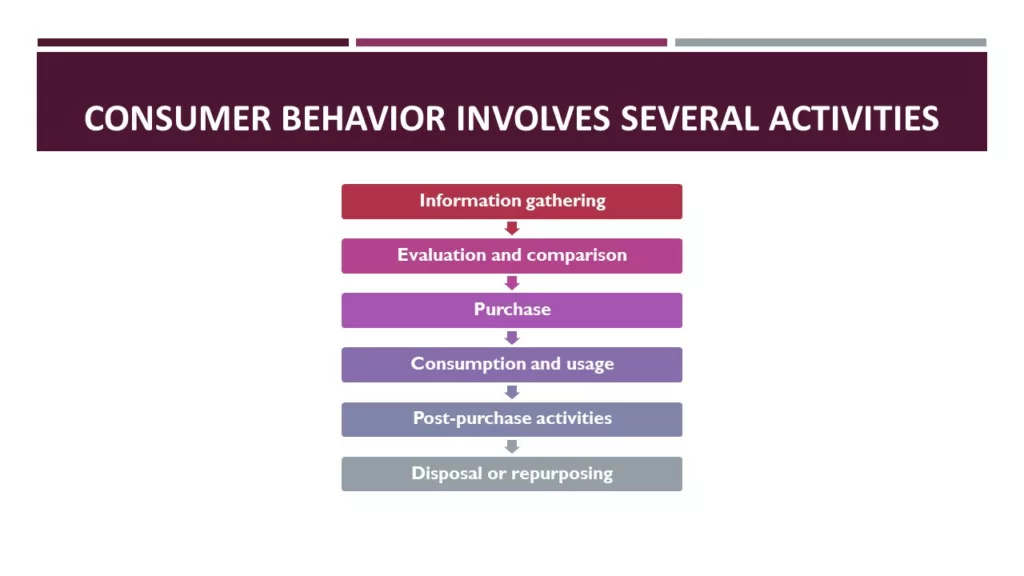
- Information gathering: Consumers engage in activities to gather information about products, services, and brands. This can involve researching online, reading reviews, seeking recommendations from friends and family, visiting stores, attending events or exhibitions, or consulting expert opinions. Information gathering activities help consumers make informed decisions and evaluate available options.
- Evaluation and comparison: Consumers engage in activities to evaluate and compare different products or brands. This includes assessing features, quality, pricing, benefits, and other relevant factors. Consumers may compare options side by side, utilize comparison websites, or rely on their own judgment and past experiences. Evaluation and comparison activities help consumers narrow down their choices and make a final decision.
- Purchase: The purchase activity involves the actual transaction where consumers acquire the chosen product or service. This can occur in physical stores, online platforms, or through other distribution channels. Consumers may engage in activities such as selecting specific variants or options, adding items to the shopping cart, providing payment information, and completing the purchase process.
- Consumption and usage: After the purchase, consumers engage in activities related to the consumption and usage of the product or service. This can include unboxing, installation, reading instructions, learning to use the product, and experiencing its benefits or functionalities. Consumers may also engage in activities such as sharing their experiences on social media, providing feedback, or seeking customer support if needed.
- Post-purchase activities: Consumers engage in activities that occur after the purchase to evaluate their satisfaction, seek support, or engage in post-purchase behaviors. This can involve activities such as reviewing the product or service, recommending it to others, seeking assistance or troubleshooting, engaging in loyalty programs, or repurchasing.
- Disposal or repurposing: Eventually, consumers may engage in activities related to the disposal or repurposing of products they no longer need or want. This can include recycling, donating, reselling, or repurposing products to minimize waste and environmental impact.
CONSUMER BEHAVIOR INCLUDES DIFFERENT ROLES
Consumer behavior includes different roles that individuals may assume throughout the decision-making process. These roles represent distinct functions and responsibilities within the purchase and consumption journey. The key roles commonly observed in consumer behavior are as follows:
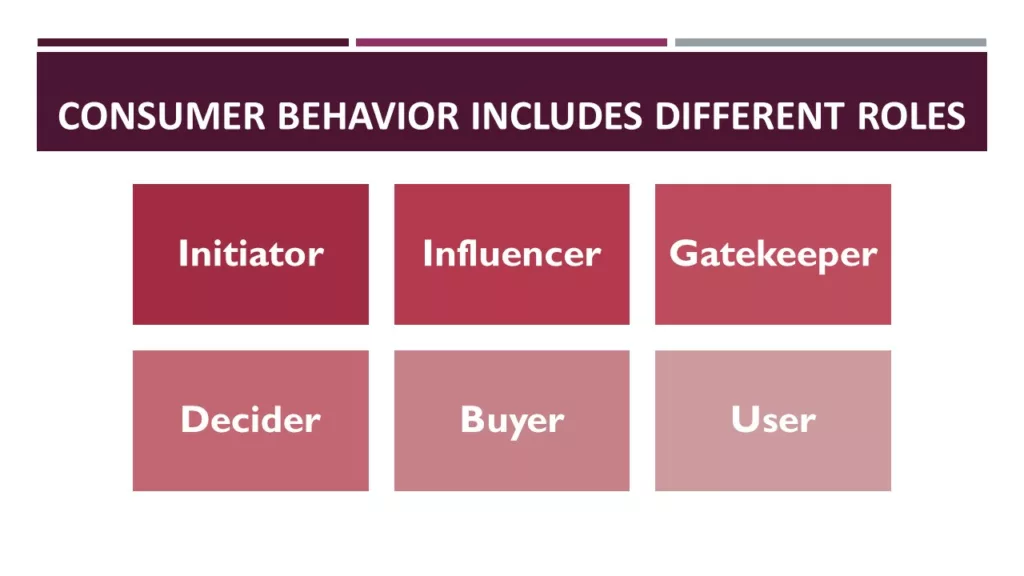
- Initiator: The initiator is the individual who recognizes a need or desire for a product or service. They may identify a problem, desire a change, or discover a new opportunity. The initiator takes the initial step by expressing their interest or raising awareness about the need for a particular product or service.
- Influencer: Influencers are individuals who impact the decision-making process by providing opinions, recommendations, or guidance. They may include friends, family members, colleagues, experts, or online influencers. Influencers shape the perceptions, preferences, and choices of the consumer through their advice, knowledge, or social influence.
- Gatekeeper: The gatekeeper controls or filters the flow of information and options available to the consumer. This role is often associated with family members or professionals who limit or shape the consumer’s access to certain products or information. For instance, parents may act as gatekeepers for children’s purchases, or professionals may filter options based on their expertise.
- Decider: The decider is the individual who ultimately makes the final decision regarding the purchase. They weigh different options, consider various factors, and choose the product or service to be acquired. The decider may be the same person as the initiator or can be someone else involved in the decision-making process.
- Buyer: The buyer is the individual who physically or digitally acquires the product or service. They are responsible for executing the transaction and completing the purchase process. The buyer may or may not be the same person as the decider, as individuals can delegate the task of purchasing to others.
- User: The user is the individual who consumes or utilizes the product or service. They are the primary beneficiary or recipient of the offering and directly experience its benefits or functionalities. Understanding the user’s needs, preferences, and satisfaction is crucial for businesses to deliver a positive user experience and encourage repeat usage.
Recognizing these different roles in consumer behavior is essential for businesses to effectively target and engage relevant individuals throughout the decision-making process. By understanding the responsibilities, motivations, and influences associated with each role, companies can develop targeted marketing strategies, communication channels, and product features that cater to the needs and preferences of various stakeholders involved in the consumer’s journey.
CONSUMER BEHAVIOR IS INFLUENCED BY EXTERNAL FACTORS
Consumer behaviour is influenced by external factors: As the consumer exists in an environment, he naturally interacts with it. We are concerned here with the external factors that affect consumer behaviour. These factors can be described briefly as follows:
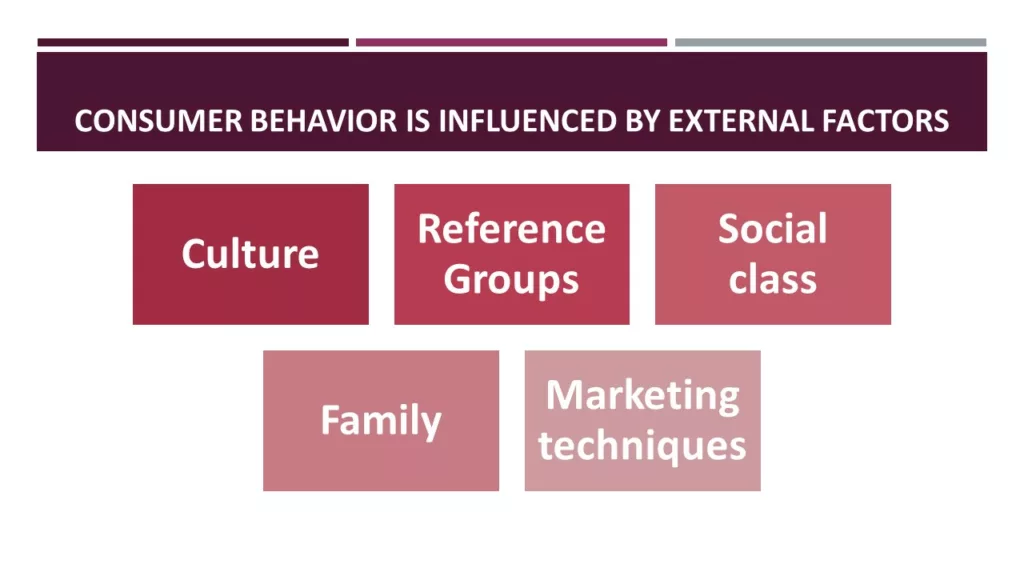
(a) Culture: Culture refers to the beliefs and values which are prevalent in a society. The consumer adopts them, and they influence purchase behaviour.
(b) Reference Groups: These include friends, clubs, and associations to which a consumer belongs. They often influence his behaviour and decisions.
(c) Social class: Social classes are part of every society. A society is segregated into classes according to the standard of living of its members. Consumer behaviour is usually affected by the consumer’s social class and its characteristics and customs.
d) Family: The family has the strongest influence on the behaviour of individuals. This is due to the early grooming and socialisation they experience with the family. Therefore, the family influence is significant, especially in the Saudi society, where family ties are strong and the tribal concept is still present and robust.
(e) Marketing techniques: These techniques include advertisements, personal selling, discounts, gifts and other ways of persuading consumers to buy. All of these are considered significant factors influencing the consumer’s purchase behaviour.
It is noteworthy that there are many other factors that affect the consumer’s purchase decisions. Among them are social, psychological marketing and income factors.
NATURE OF CONSUMER BEHAVIOR PDF
| Also Study: |
| Need for studying consumer behavior in marketing |